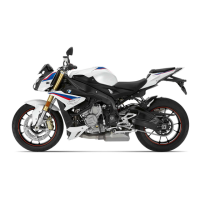Antilock Brake System
Race ABS
Partially integral brake
Your motorcycle is equipped with
a partially integral brake configu-
ration. Both front and rear brakes
are applied simultaneously when
you pull the handbrake lever.
The footbrake lever acts only on
the rear brake.
ATTENTION
Attempt at a burn-out de-
spite integral function
Damage to rear-wheel brake and
clutch
Only do Burn Outs with the
ABS switched off.
How does the ABS work?
The maximum braking force that
can be transferred to the road
surface is partially dependent on
the friction coefficient of the road
surface. Gravel, ice, snow and
wet roads offer a considerably
poorer friction coefficient than a
dry, clean asphalt surface. The
poorer the friction coefficient of
the road surface is, the longer
the braking distance will be.
If the maximum transferable brak-
ing force is exceeded when the
rider increases the brake pres-
sure, the wheels begin to lock
and driving stability is lost, and a
fall can result. Before this situa-
tion occurs, ABS intervenes and
adjusts the brake pressure to the
maximum transferable braking
force. This enables the wheels
to continue to turn and maintains
driving stability regardless of the
road surface condition.
What happens when
rough roads are
encountered?
Bumpy or rough roads can briefly
lead to a loss of contact be-
tween the tires and the road sur-
face, until the transferable brak-
ing force is reduced to zero. If
braking is carried out in this sit-
uation, ABS must reduce the
brake pressure to ensure driv-
ing stability when restoring con-
tact to the road. At this point in
time, the BMW Motorrad Integral
ABS must assume extremely low
friction coefficients (gravel, ice,
snow) so that the running wheels
turn in every imaginable case and
the driving stability is ensured.
After detecting the actual con-
ditions, the system adjusts the
optimum brake pressure.
8
118
z
Technology in detail

